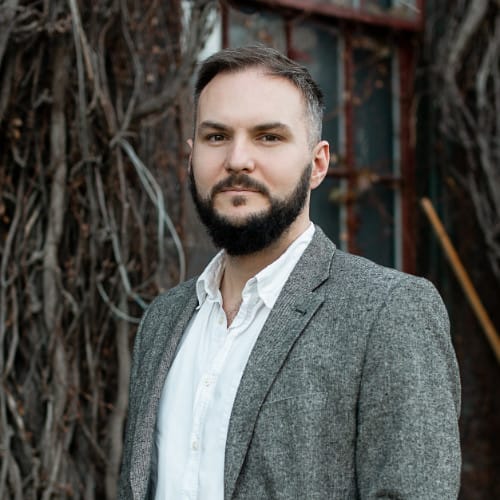The mental health landscape is undergoing a sea change, in part, due to increased recognition of psychedelic-assisted therapy as a paradigm shift in the field. This new avenue for treatment offers a rare opportunity to address the root cause of trauma – all more quickly than usual approaches primarily oriented to symptoms. As this new territory unfolds, practitioners must navigate a unique set of possibilities and challenges.
Successfully integrating psychedelic-assisted therapy into practice can include:
– Building novel skills through training programs like Vital
– Overcoming imposter syndrome
– Successfully applying training theory in the real world
– Adopting new integrative care workflows
– Attracting enough new clients to sustain one’s business
So, where should you begin? As a practitioner, preparing for these challenges and opportunities holistically will set you up for deep client impact, and personal and professional fulfillment.

Psychedelic Therapy as a Bridge Between Modern and Traditional
Overall, modern and traditional medicine traditions diverge across several vectors; there is merit to both modern and traditional approaches, and tremendous value in enabling a complementary relationship between them. Though modern medicine is capable of performing miracles in treating illness, in practice, patients in a Western context primarily seek conventional healthcare when sick. Especially in the case of U.S. healthcare, the system’s design financially rewards providers when they treat illness or injury, not when they help build a healthy lifestyle. The concept of “health” in the West is generally limited to the physical body: whether one’s heart is beating in rhythm, musculature working harmoniously, and they’re free of observable illness. U.S. health insurance companies only started covering mental healthcare broadly 15 years ago – a striking proxy for mental health’s lagging priority – and still don’t do it adequately. At the same time, modern medical innovation is grounded in research data, and only canonized following randomized controlled trials (RCTs), the gold standard of medical research, which ensures conclusions are drawn without bias. The benefit of this approach is that it safeguards the medical field from interventions that are not safe or effective.
Traditional medicines from across the world usually represent a broader and more integrative approach, equally focused on balancing the mind, body, and spirit dimensions to achieve a whole-person health outcome for an individual and community. Functionally speaking this may mean building a mindfulness and embodiment practice, immersing yourself in community, and cultivating a deep relationship with nature and beyond. Harnessing practices that move energy effectively throughout your body can build tremendous resilience, equanimity, and aliveness, which can reflect quantitatively in biomarkers too. While traditional medicine generally lacks the evidence base assembled through RCTs, its many lineages and modalities have gained significant support in recent years, accelerated by a mental health epidemic and tremendous anecdotal impact.
Psychedelic therapy represents a unique bridge between these two worlds. It has descended from long lineages of Indigenous traditions across the world, but legal access in the West will be initially limited to substances approved by the FDA and delivered by clinicians with formal credentials. Whereas traditional talk therapy often centers on distinct sessions, the psychedelic integration process is a continuous therapeutic container, and often incorporates embodied practices like breathwork, yoga, journaling, and meditation, as core agents of change in between sessions where lasting transformation happens. Clients themselves are viewed as the agents of change, empowered to take full ownership of their own healing. The medicine serves as a potent catalyst for this evolution, and the psychedelic practitioner is a space-holder and champion for the client on their journey.

Addressing Imposter Syndrome Among New Practitioners
Given these differences, coupled with traditional rigors of embarking on a major professional change, it isn’t surprising that new practitioners often experience a sense of imposter syndrome. While methods of working through imposter syndrome are well-established, there are practical approaches which new psychedelic practitioners in particular can take.
First, participating in a peer community of diverse types of practitioners can help combat feelings of “stuckness” and isolation. The psychedelic therapy space attracts providers of different backgrounds, mindsets, and worldviews – but this can feel abstract unless providers have ongoing structured opportunities to collaborate as professionals. Peer groups that meet regularly, or broader digital communities (ideally both), can help validate thinking, enrich perspectives, and make the often solitary business of holding space more collaborative and fun. In many cases collaboration can be literal: providers with different specializations often establish referral relationships that prove to be in the best interest of a client. They can also cultivate supervisory or accountability relationships, and they can overcome initial logistical friction points, like feeling comfortable with setting appropriate payment rates.
Second, providers can create structure for ongoing client communication and measurement, helping them progress from intention setting to lasting transformation. This growth can be charted quantitatively, in the form of anxiety/depression scoring or practitioner’s own “homebrew” assessments, and qualitatively, in the form of collaboratively tracking and focusing on client progress milestones beyond their initial intention. In either case, observing client progress can give providers a sense of organization and confidence in attracting new clients in the future.
The Right Systems to Support Psychedelic Therapy Workflows
New providers stepping into this space may be frustrated with workflows that are not provider-centric and an abundance of outdated or unsupportive technology systems. A recent study by the National Council for Mental Wellbeing suggested that a third of the behavioral health workforce spends more time on admin than actually working with clients. There are many administrative functions necessary to support the modern practice: intake and scheduling, session note-taking, invoicing, and client communication, to name a few. When performed on separate systems, providers are forced to repeatedly context-switch, which depletes energy and pulls them away from their core mission: supporting client growth.
Beyond practice management’s traditional requirements, structuring the preparation and integration container across sessions may look different from traditional therapy workflows. A client’s integration work starts – it doesn’t stop – when a session with their provider ends. As such, many providers are meticulous about sharing and tracking recaps, and guidance and resources between sessions, which can include embodied practice recordings, podcasts or journaling prompts. Seasoned providers end up building out a library of resources to share with clients, as opposed to searching for them ad-hoc, but managing this ever-growing library and sharing via separate communication tools can be onerous.
Providers creating an on-going digital container often do so across multiple mediums (email, text, Whatsapp), which can quickly become disorganized and lose most of the context; this can lead to struggles maintaining momentum with clients if they’re forced to track down different conversation threads. For clients, provider resource sharing and communication is only as effective as it is utilized, and when spread across different surfaces, clients are less likely to engage in integration resources. On the other hand, using familiar communication channels often means co-locating client communications with personal messages across the chat apps and email. This can be tempting for ease of use, but over the long run proves hard to maintain when personal and professional lives start to bleed into one another.
Existing technologies, such as Electronic Medical Records (EMRs), unfortunately, have not evolved to support the modern client-centric dynamic so critical in this space. An EMR platform fulfills the primary capability of insurance billing and reimbursement, but even the most technologically innovative Patient Portals (the communication module of most EMRs) remain clunky, inflexible, and largely logistically-focused. They haven’t kept up with the rising modern client expectations for a simple, intuitive, and well-designed user experience they take for granted in other areas of their lives.
Attracting New Clients To Your Psychedelic Therapy Practice
We won’t bury the lede here: there is no magic bullet to building a meaningful client panel for your psychedelic-assisted therapy practice, but there are best practices you can follow. For those with the time and means, investing in an attractive website, paying for web traffic to your site, and optimizing how online searches are triaged to your site (SEO), can all be effective for growing your visibility and presence online. There’s also been a proliferation of online directories which can help generate leads, with varied success rates; there’s little downside to joining these, though from a client’s perspective it can be tough to differentiate among providers, and client routing can be opaque. Providers who anticipate a deluge of new clients should temper their expectations.
For psychedelic practitioners, client connection and trust is paramount, so successful providers often establish their own unique niche: a subset of the market with which they will uniquely resonate, and from which they will derive energy. Are you a sex therapist who does your best work helping divorced middle aged men re-discover their intimacy groove? Does your cultural heritage give you a unique perspective on de-colonization and working with intergenerational trauma? Whatever the case, expert providers own their narrative and unique perspective; it’s not bad to be clear and unapologetic in your messaging so that clients know exactly why they’re there. Counter-intuitively, loosely appealing to everyone typically means you’re not strongly appealing to anyone. Take a stance and communicate your message confidently.
Psychedelic providers can also generate client referrals by investing in peer communities of practice (which, consequently, also benefits from providers inhabiting a specific niche and specialization). In holistic circles, providers tend to create informal “constellations” of care in support of client transformation. Clients might benefit from working variously with a psychedelic therapist, a breathwork facilitator, and a yoga therapist (as an example) to hardwire new behaviors. Optimal client care is, in part, dependent on those providers building personal relationships, understanding each other’s unique approaches, and trusting each other’s work.
Modern Solutions for Modern Practitioner Challenges
Here’s where intuitive tech comes in. Yuriy Blokhin, Founder & CEO of Homecoming shares, “We built Homecoming with the goal of equipping providers who blend both mystical and medical traditions with the tools, content, and community to do their life’s best work. What if, we thought, we could create an all-in-one platform that streamlined into a single place what you need to get best client results with how you learn and grow as professionals?“
Working in direct collaboration with psychedelic practitioners, Homecoming brings all client communication together under one roof, and co-locates it with a customizable library for providers to have everything at their fingertips to support client integration and drive impact. Communications are flexibly sent from an intuitive web dashboard or practitioner mobile app to client’s preferred inbox, whether it’s SMS, email, or a dedicated client mobile app, while letting you see all your client conversations from a single view in Homecoming, so you never “lose the thread” of conversation and can present confidently and professionally. Administrative functions like session note-taking, scheduling, and invoicing, are integrated, so you can reduce time spent away from deep client work.
Holistic practitioners who work with Homecoming are constantly learning and growing through the adoption of new modalities and techniques, which inspired development of the Homecoming content ecosystem. Leading providers across the spectrum of mystical and medical traditions have curated resources for practitioners on Homecoming to discover and further curate their libraries, and are immediately able to share their new findings with clients. The provider community, embedded in the platform, is the ideal place to connect with peers, build professional relationships, and pressure-test new approaches. The vision, Homecoming says, is to build a collaborative network of practitioner factions across different healing traditions, and to serve as an educational bridge for all providers, to the benefit of clients everywhere.
Guiding the Way Forward
As the realm of psychedelic-assisted therapy continues to unfold, practitioners find themselves at the forefront of a transformative approach to healing. For providers to navigate this new paradigm requires them to anticipate and embrace the distinct demands of the field. This means not only developing expertise in this new modality itself, but building familiarity with adjacent holistic approaches, and preparing one’s mindset and systems for a new way of supporting client impact. Psychedelic medicine will never be a panacea, but preparing providers to thrive in this new landscape is an important step in a broader expansion of consciousness and reduction of suffering.



